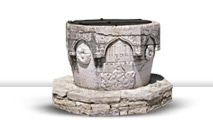Izola
On the northwestern coast of Istria, on the one-time island, lies the only Istrian coastal town that boasts a history of thermal tourism.
It was inhabited in the 1st c. BC which is the period that the oldest traces of the large luxurious complex with a Roman villa and pier on the seaside in Simon’s Bay, only a kilometer from Izola, date from. It was an important economic complex that coexisted with other villas on the island.
The Roman settlement was for the first time fortified probably in the Late Roman period, and life continued on in the Early Middle Ages in the protected settlement. In 972 Emperor Otto I granted Izola to the Venetian dodge, but it soon became property of the Patriarch of Aquileia. In 1031 the mighty Patriarch of Aquileia Popone granted it to the Monastery of Benedictine nuns of St. Mary in Aquileia. They collected the tithe, while the civil government was entrusted to its own administrator. They kept records of all events: their archives contain documents about the Benedictine monastery of St. Peter that was mentioned in the 13th c., and about St. Catherine’s monastery, mentioned since the 15th c., unless it was the same monastery that changed its titular. The centuries between these records were difficult times for Izola, marked with constant rivalry and battles with Koper and Piran. The independence it obtained in the mid-13th c. lasted shortly: as early as 1280 the town was under Venice.
The renovation and construction of churches and palaces intensified in the 15th and 16th cc. This is when the Manzioli Palace (1470) was built, part of which in the Renaissance was renamed to Lovisato Palace. Further, the Communal Palace was built, St. Maurus Basilica was enlarged (1547), the old octagonal Parish Church of St. Mary of Haliaetum was reconstructed (1553), and the Franciscan monastery was built. The repeated construction swing took place in the 18th c. when the Church of St. Mary of Haliaetum was reconstructed, while the edge of the medieval core became the site of a new luxurious palace of the Besenghi degli Ughi family. The small medieval town completely changed its appearance in the 19th c. In the beginning of the century, the defensive walls were pulled down and their material was used to fill in the channel between the island and the mainland. The architectural transformation was not the only novelty.
The discovery of the thermal water spring near St. Peter’s Church changed the development of Izola. The thermal baths complex that had a ballroom and other facilities was opened as early as 1824 which made Izola a popular tourist town. The thermal baths were later turned into a fish processing plant, which began its activity in the second half of the century, and soon became a new source of income of the inhabitants.
In spite of wartime events in the 20th c., after the 1950s, Izola grew into a successful town of specific economic branches of which the most popular was the toy factory Mehanotehnika.
Visit:
Parenzana Museum, the narrow gauge railway that between 1902 – 1935 connected Trieste with Poreč through a number of towns.
Interesting facts:
The well known cartographer Pietro Coppo settled in Izola in 1499. In his last work Del sito de Listria he brings a map of Istria, a copy of which inscribed in stone can be seen in the Pietro Coppa Park in the center of town. A collection of his maps is kept in the Maritime Museum in Piran.





















